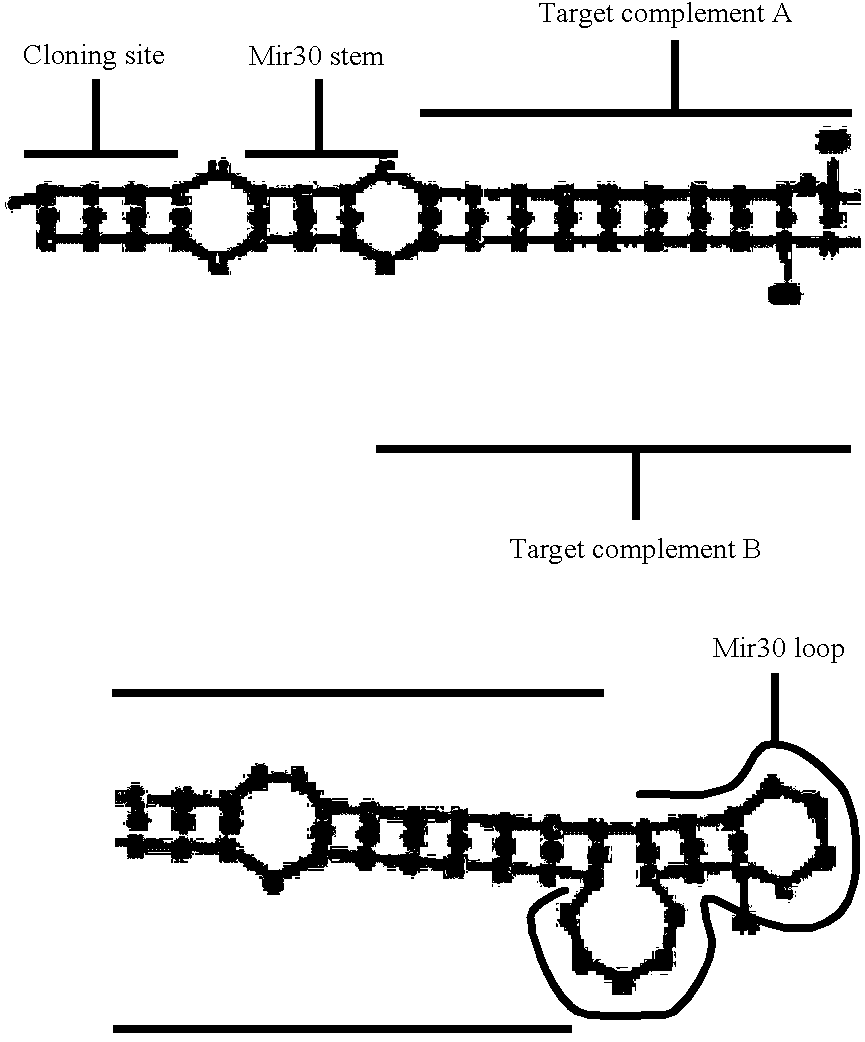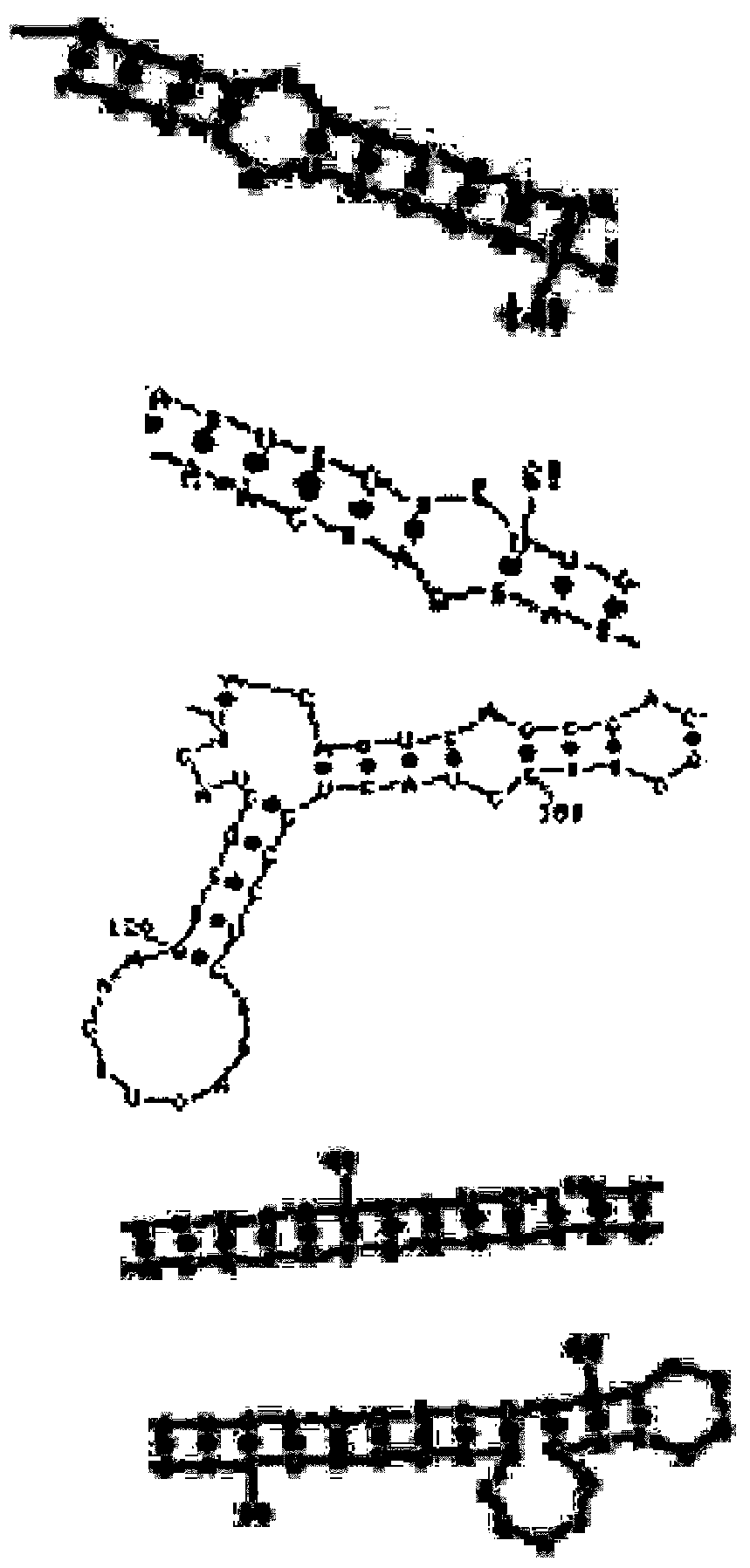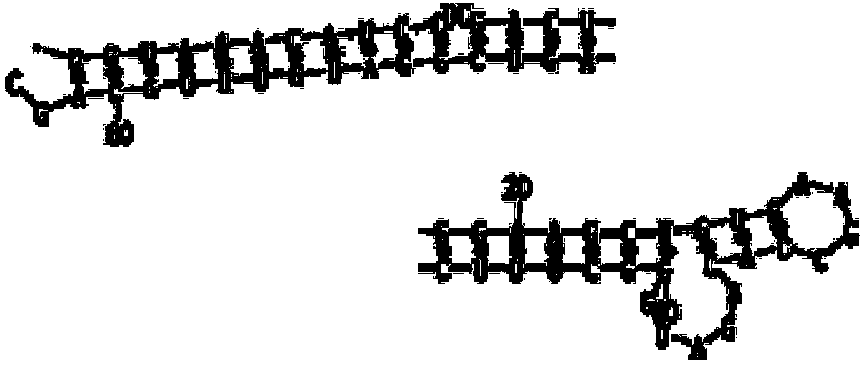Use of interfering RNA in the production of transgenic animals
a technology of interfering rna and transgenic animals, which is applied in the field of cell and animal production, can solve the problems of low success rate, time-consuming and laborious production and screening programs, and current techniques are limited in their ability to meet these requirements, and achieve the effect of not disrupting and minimal effect on the homeostasis of the cell or animal
- Summary
- Abstract
- Description
- Claims
- Application Information
AI Technical Summary
Benefits of technology
Problems solved by technology
Method used
Image
Examples
example 1
Targeting Families of Genes
[0330] For specific targeting of a family of genes, a desired subset of genes, or specific alleles of a gene or gene family, a representative sample of sequences is obtained. These sequences are compared to identify areas of similarity. The comparison determines areas of similarity and identity between given gene families, as well as within subsets of sequences within a family. In addition, this analysis determines areas of similarity and identity between alleles of family members. By considering these sequences, regions are identified that can be used to target either the entire family, subsets of family members, individual family members, subsets of alleles of individual family members, or individual alleles of family members.
[0331] The results of a typical analysis are shown in FIG. 8. In this analysis, Region 2 can target all members of the given 4-gene family. Likewise, the sequence of Region 3 differentiates Gene 1 and 2 from Gene 3 and 4, and Regi...
example 2
Use of RNA Interference to Inhibit Porcine Endogenous Retrovirus
[0336] RNA interference is used to heritably suppress expression of a family of related sequences encoding different yet homologous retroviruses found in pigs. Broadly, a transgene is constructed that results in production of an iRNA molecule with sense and inverted antisense sequences, homologous to a region of the porcine endogenous retrovirus genome that is conserved between PERV variants, at least three of which are known (PERV-A, -B and C). The transgene is added to the genome of a pig to produce a genetic line that heritably expresses an RNA molecule that can self hybridize to form dsRNA. This RNA induces interference of expressed porcine endogenous retrovirus in each cell that expresses the transgene. Not only is total PERV production severely down regulated, but recombination between targeted variants may not produce a novel untargeted variant. Cells, tissues, or organs from such animals can be used for xenotra...
example 3
Sequential Cloning of Hairpin Oligonucleotides
[0407] To assemble oligos for clustered interference RNA, linker sequences must the considered to prevent unintentional structures from forming. If the same restriction sites are used sequentially, homologies at the base of the hairpin can cause unintentional base pairing. For example, if a vector is designed with two, non-compatible restriction sites a sequence can be cloned directionally into those two sites. In the process, the upstream site can be destroyed and also re-supplied to the new vector in the downstream region in preparation for the next hairpin.
[0408] Vector ends after being cut with BclI and MluI:
BclIM1ulOverhangOverhangNNNT 3′3′CGCGTNNNNNNACTAG 5′5′ANNN
[0409] Hybridized Oligonucleotides:
(Seq ID No 44)5′GATCtgcgcTTAGATCCAGGGCTCATAATgtgaagccacagatgATTATGAGCCCTGGATCTAATtgcTGATCActagtA 3′(Seq ID No 45)3′acgcgAATCTAGGTCCCGAGTATTAcacttcggtgtctacTAATACTCGGGACCTAGATTAacgACTAGTgatcaTGCGC 5′
[0410] Resulting Clone:
Destroyed...
PUM
| Property | Measurement | Unit |
|---|---|---|
| Length | aaaaa | aaaaa |
| Gene expression profile | aaaaa | aaaaa |
| Recombination enthalpy | aaaaa | aaaaa |
Abstract
Description
Claims
Application Information
 Login to View More
Login to View More - R&D
- Intellectual Property
- Life Sciences
- Materials
- Tech Scout
- Unparalleled Data Quality
- Higher Quality Content
- 60% Fewer Hallucinations
Browse by: Latest US Patents, China's latest patents, Technical Efficacy Thesaurus, Application Domain, Technology Topic, Popular Technical Reports.
© 2025 PatSnap. All rights reserved.Legal|Privacy policy|Modern Slavery Act Transparency Statement|Sitemap|About US| Contact US: help@patsnap.com



